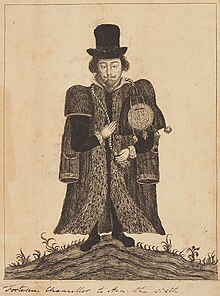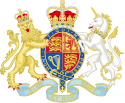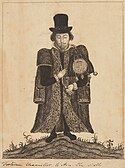John Fortescue (Jurist)
Sir John Fortescue (* 1394 in Norris, Devonshire; † 1476 in Gloucestershire) war ein englischer politischer Schriftsteller in der Renaissance.
Leben
Fortescue entstammte einer Adelsfamilie aus Devonshire und wurde 1442 oberster Richter des königlichen Gerichtshofs. Als König Eduard IV. den Thron bestieg (1461), musste Fortescue erst nach Schottland und dann nach Frankreich fliehen, doch schloss er 1473 mit dem König Frieden.[1] Als herausragender Rechtsgelehrter und Verfasser des bedeutenden juristischen Werkes De laudibus legum Angliae[1] ist er einer der Gründervater der britischen Verfassung. Fortescue befürwortete die Stärkung des Unterhauses als Gegenpol zum Oberhaus, dem House of Lords.
Werke
- Sir John Fortescue: "On the Laws and Governance of England", 1997, Cambridge University Press, ISBN 0521434459
Einzelnachweise
- ↑ a b Royle, Trevor: The Wars of the Roses; England´s first civil war. Abacus, London, 2009, ISBN 978-0-349-11790-4, S. 445
Weblinks
- Porträt von Sir John Fortescue
- Fortescue - Auszüge aus der Familiengeschichte
- Literatur von und über John Fortescue (Jurist) in der bibliografischen Datenbank WorldCat
- Buch A learned commendation of the politique lawes of England
Literatur
- Ralph A. Griffiths: The Reign of Henry VI. The exercise of royal authority. 1422–1461. Benn, London u. a. 1981, ISBN 0-510-26261-9.
| Personendaten | |
|---|---|
| NAME | Fortescue, John |
| ALTERNATIVNAMEN | Fortescue, Sir John |
| KURZBESCHREIBUNG | englischer politischer Schriftsteller |
| GEBURTSDATUM | 1394 |
| GEBURTSORT | Norris, Devonshire |
| STERBEDATUM | 1476 |
| STERBEORT | Gloucestershire |
Auf dieser Seite verwendete Medien
Autor/Urheber: Sodacan, Lizenz: CC BY-SA 3.0
Royal Coat of Arms of the United Kingdom of Great Britain and Northern Ireland in the style used by the Government of Queen Elizabeth II from 1952 to 2022 (as used in all places except Scotland).
| “ | Quarterly, First and Fourth Gules three lions passant guardant in pale Or armed and langued Azure (for England), Second quarter Or a lion rampant within a double tressure flory counter-flory Gules (for Scotland), Third quarter Azure a harp Or stringed Argent (for Ireland), the whole surrounded by the Garter; for a Crest, the imperial crown Proper; for Supporters, dexter a lion rampant guardant Or crowned as the Crest, sinister a unicorn Argent armed, crined and unguled Proper, gorged with a coronet Or composed of crosses patée and fleurs de lys a chain affixed thereto passing between the forelegs and reflexed over the back also Or; Motto 'Dieu et mon Droit’ ('God and my Right') below the shield. | ” |
- PINCHES, J.H & R.V., The Royal Heraldry of England, 1974, Heraldry Today.
A drawing of Sir John Fortescue (c. 1394 – c. 1480), Lord Chief Justice of England and Wales, in anachronistic 17th-century dress with an oversized Great Seal of England bearing the Royal Arms and hanging from a cord draped against the left side of his chest.



